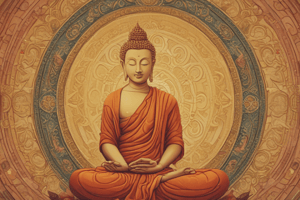Podcast
Questions and Answers
What is the main purpose of Buddhist pilgrimages?
What is the main purpose of Buddhist pilgrimages?
- To participate in cultural immersion experiences
- To practice mindfulness and meditation
- To travel to sacred sites associated with the life of the Buddha (correct)
- To learn about Buddhist architecture
What is a characteristic feature of Buddhist architecture?
What is a characteristic feature of Buddhist architecture?
- Dome-shaped structures housing relics or sacred objects
- Multi-tiered towers
- Places of worship and learning
- All of the above (correct)
What is cultural immersion in Buddhist tourism?
What is cultural immersion in Buddhist tourism?
- Practicing mindfulness and meditation
- Staying in Buddhist monasteries
- Visiting Buddhist pilgrimage sites
- Participating in local customs, traditions, and daily life (correct)
What is the main focus of mindfulness retreats?
What is the main focus of mindfulness retreats?
What is unique about monastery stays?
What is unique about monastery stays?
What is a benefit of participating in cultural immersion experiences?
What is a benefit of participating in cultural immersion experiences?
Match the following Vastu remedies with their purposes:
Match the following Vastu remedies with their purposes:
Match the following Vastu techniques with their applications:
Match the following Vastu techniques with their applications:
Match the following Vastu elements with their benefits:
Match the following Vastu elements with their benefits:
Match the following Vastu remedies with their characteristics:
Match the following Vastu remedies with their characteristics:
Match the following Vastu techniques with their purposes:
Match the following Vastu techniques with their purposes:
Match the following Vastu elements with their applications:
Match the following Vastu elements with their applications:
Flashcards are hidden until you start studying
Study Notes
Pilgrimages
- Buddhist pilgrimages involve traveling to sacred sites associated with the life of the Buddha or other important Buddhist figures
- Four main pilgrimage sites in Buddhism:
- Lumbini (Nepal): birthplace of the Buddha
- Bodh Gaya (India): site of the Buddha's enlightenment
- Sarnath (India): site of the Buddha's first sermon
- Kushinagar (India): site of the Buddha's death
- Pilgrims often follow the Buddha's footsteps, visiting these sites and performing rituals such as meditation, chanting, and offering prayers
Buddhist Architecture
- Buddhist architecture varies across cultures and regions, but often features distinctive characteristics such as:
- Stupas (dome-shaped structures housing relics or sacred objects)
- Pagodas (multi-tiered towers)
- Temples (places of worship and learning)
- Monasteries (residences for monks and nuns)
- Examples of notable Buddhist architectural sites:
- Borobudur Temple (Indonesia)
- Angkor Wat (Cambodia)
- Potala Palace (Tibet)
Cultural Immersion
- Cultural immersion in Buddhist tourism involves participating in local customs, traditions, and daily life
- Examples of cultural immersion experiences:
- Attending Buddhist festivals and celebrations
- Participating in traditional Buddhist ceremonies and rituals
- Staying with local families or in monasteries
- Learning traditional Buddhist arts and crafts
- Cultural immersion allows tourists to deepen their understanding of Buddhist culture and connect with local communities
Mindfulness Retreats
- Mindfulness retreats offer a chance to practice meditation, yoga, and other mindfulness practices in a peaceful, natural setting
- Retreats often feature:
- Guided meditation sessions
- Yoga and tai chi classes
- Healthy, vegetarian meals
- Nature walks and outdoor activities
- Mindfulness retreats aim to promote relaxation, stress reduction, and personal growth
Monastery Stays
- Monastery stays allow tourists to live alongside Buddhist monks and nuns, experiencing daily monastic life
- Examples of monastery stay experiences:
- Participating in daily meditation and prayer sessions
- Helping with monastic chores and tasks
- Learning about Buddhist philosophy and teachings
- Sharing meals with the monastic community
- Monastery stays provide a unique opportunity to learn about Buddhist monasticism and connect with the monastic community
Pilgrimages
- Buddhist pilgrimages involve traveling to sacred sites associated with the life of the Buddha or other important Buddhist figures
- Four main pilgrimage sites in Buddhism are:
- Lumbini (Nepal), the birthplace of the Buddha
- Bodh Gaya (India), the site of the Buddha's enlightenment
- Sarnath (India), the site of the Buddha's first sermon
- Kushinagar (India), the site of the Buddha's death
Buddhist Architecture
- Buddhist architecture varies across cultures and regions
- Distinctive characteristics of Buddhist architecture include:
- Stupas (dome-shaped structures housing relics or sacred objects)
- Pagodas (multi-tiered towers)
- Temples (places of worship and learning)
- Monasteries (residences for monks and nuns)
- Examples of notable Buddhist architectural sites include:
- Borobudur Temple (Indonesia)
- Angkor Wat (Cambodia)
- Potala Palace (Tibet)
Cultural Immersion
- Cultural immersion in Buddhist tourism involves participating in local customs, traditions, and daily life
- Examples of cultural immersion experiences include:
- Attending Buddhist festivals and celebrations
- Participating in traditional Buddhist ceremonies and rituals
- Staying with local families or in monasteries
- Learning traditional Buddhist arts and crafts
Mindfulness Retreats
- Mindfulness retreats offer a chance to practice meditation, yoga, and other mindfulness practices in a peaceful, natural setting
- Retreats often feature:
- Guided meditation sessions
- Yoga and tai chi classes
- Healthy, vegetarian meals
- Nature walks and outdoor activities
- Mindfulness retreats aim to promote relaxation, stress reduction, and personal growth
Monastery Stays
- Monastery stays allow tourists to live alongside Buddhist monks and nuns, experiencing daily monastic life
- Examples of monastery stay experiences include:
- Participating in daily meditation and prayer sessions
- Helping with monastic chores and tasks
- Learning about Buddhist philosophy and teachings
- Sharing meals with the monastic community
Vastu Remedies for Dosh
- Implementing Vastu corrections without demolishing the existing structure to balance and harmonize the energy in the space
Techniques for Vastu Correction
- Mirror placement to deflect negative energy
- Placing Vastu-compliant decorative items (e.g., pyramids, crystals)
- Using color therapy and aromatherapy to balance energies
Dosh Nivaran Puja
- A ritual performed to remove negative effects of Dosh (Vastu defects)
- Performed by a qualified priest or Vastu expert
- Involves recitation of specific mantras and prayers, offering of prayers and rituals to appease the gods, and use of sacred items (e.g., havan, yajna) to purify the space
Vastu Yantra for Dosh Remedy
- A geometric symbol used to balance and correct Vastu defects
- Yantras absorb and neutralize negative energy, attract positive energy and vibrations, and enhance the effects of other Vastu remedies
- Commonly used Yantras for Dosh remedy: Sri Yantra, Ganesh Yantra, Vastu Yantra
Vastu Colors for Dosh Correction
- Specific colors used to balance and correct Vastu defects
- Colors can absorb and neutralize negative energy, enhance positive energy and vibrations, and influence the mood and behavior of occupants
- Commonly used colors for Dosh correction: Yellow (for prosperity and happiness), Orange (for energy and enthusiasm), Green (for balance and harmony)
Dosh Remedies for Wealth and Prosperity
- Vastu remedies to attract wealth and prosperity
- Techniques:
- Placing a wealth-attracting Yantra (e.g., Lakshmi Yantra) in the north direction
- Keeping a small water fountain or aquarium in the north direction
- Placing a mirror opposite a door or window to reflect and attract wealth energy
Studying That Suits You
Use AI to generate personalized quizzes and flashcards to suit your learning preferences.






